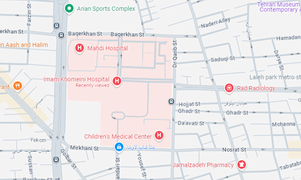|
Dec 16 2025

Research Center for Molecular and Cellular Imaging
Tehran University of Medical Sciences
Latest content
- 1403/11/01 New version of microCT imaging device begins operation
- 1403/10/26 Correlation study of quantitative and qualitative analysis results in PET/CT imaging of temporal lobe epilepsy patients in Iran
- 1403/10/26 Design and production of a laboratory sample of an iodine absorption measuring device to measure thyroid gland activity
- 1403/10/26 Design, modeling, and evaluation of a mammalian pet system using Monte Carlo simulation
- 1403/10/18 Evaluation of Leakage Dose from Radiology Rooms in Tehran University of Medical Sciences Hospitals
- 1403/10/17 Holding the First Surgical Procedures Workshop Using Simulators in the Country
- 1403/10/17 Awarding the National NEXT Technology Prize
SURGEOGUIDE II

Gamma probe system: SURGEOGUIDE II model
A gamma probe is a handheld device used for intraoperative use following interstitial injection of a radionuclide, to locate regional lymph nodes by their radioactivity. It is used primarily for sentinel lymph node mapping and parathyroid surgery. Radionuclides which uses usually are Tc-99m, I-131 & F-18. Gamma probes can also be used in open surgery, laparoscopy and theroscopy (inside the body), and can be used externally (outside the body). Most use of gamma probes is in Sentinel Lymph Node Biopsy (SLNB) and Radio-Guided Occult Lesion Localization (ROLL). But these systems can be used in all cases where the detection of small points with high activity distribution, high sensitivity and resolution is desired.
Clinical applications:
Breast cancer
Gynecological cancers (cervical, ovarian, uterine, vaginal and vulvar)
Melanoma and other types of skin tumors
Head & Neck
Endocrine cancers (thyroid, parathyroid)
Urology cancers (prostate, bladder, testicular, kidney and penile)
Nuclear Medicine (localization of gamma labeled areas)
Probe specifications:
Three types of Probes: Large Tip, Small Tip, Endoscopic
Length: 21 cm
Tip Diameter: 16 mm (Large), 11 mm (Small), 10 mm (Endoscopic)
Stainless Steel Body , Tungsten Collimator
Crystal: CsI(Tl)
NEMA-NU3 standard test results:
Sensitivity: ~2K cps/MBq @ 3 cm
Shielding Efficiency: 99.6 % for Tc-99m
Energy Resolution: < 11% FWHM for Tc-99m
Angular Resolution: 30˚, 45˚, 95˚ (optional)
Local Resolution: < 40 mm FWHM at 5 cm distance (For Large Probe)
System Specifications:
5 digit display
Linear bar graph
Sound modulated with count rate
Scale select volume
Isotope select volume
Beep/FM sound
12 DC – 40W Adapter

